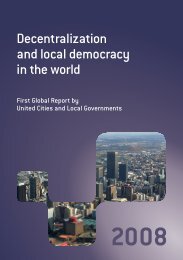Making Cities Resilient Report 2012
Making Cities Resilient Report 2012
Making Cities Resilient Report 2012
Create successful ePaper yourself
Turn your PDF publications into a flip-book with our unique Google optimized e-Paper software.
disasters and build resilience, there are also many similarities in the challenges they face and in their<br />
political will to invest in making their cities safer.<br />
The focus on resilience as the theme for this report reflects a mounting recognition that disaster risk<br />
reduction, climate change adaptation and sustainable development are inextricably linked. These issues<br />
present mutually dependant challenges, which require collaborative, integrated strategies, strong<br />
governance, and innovative technological and financial solutions. Nowhere is this more evident than in<br />
cities. Complex, unique in their political and economic structures, and widely varying in the vulnerabilities<br />
they face, cities—and the growth they will experience over the next two decades—will give way to some of<br />
the 21st century’s most important social and economic challenges and opportunities.<br />
<strong>Report</strong> aim and structure<br />
The aim of the report is to provide a global snapshot of local-level resilience building activities and identify<br />
trends in the perceptions and approaches of local governments toward disaster risk reduction, using the<br />
Ten Essentials for <strong>Making</strong> <strong>Cities</strong> <strong>Resilient</strong> developed by the Campaign as a framework (see back-cover).<br />
This report also analyses the factors that enable urban disaster risk reduction activities, including how the<br />
Campaign has helped improve local knowledge of disaster risk and support capacity building.<br />
The <strong>Making</strong> <strong>Cities</strong> <strong>Resilient</strong> Campaign seeks to encourage and support all urban centers to reduce risks<br />
and become resilient to disasters. This includes urban centers that meet the conventional definition of a<br />
‘city’ in terms of land size and population, as well as other sub-national administrations of different sizes<br />
and levels, including regional, metropolitan and provincial areas, as well as municipalities and townships.<br />
For the purposes of this report, the term ‘city’ is taken to include all these urban centers and is used<br />
interchangeably with the term ‘local governments’.<br />
The report is based on the wealth of material that cities involved in the Campaign have self-reported to<br />
UNISDR and shared publicly since 2010. This includes detailed presentations for events, award documents,<br />
and results of the HFA: Local Governments Self Assessment Tool (see Annex 3). A number of individual<br />
interviews were also conducted with city leaders in preparation for this report.<br />
The report is divided into five chapters, featuring a combination of analysis of cities’ resilience activities<br />
and short stories from cities on good practice in urban disaster risk reduction. Chapters one and two draw<br />
conclusions on the core building blocks and enabling factors for urban resilience and the Campaign’s role<br />
in driving disaster risk reduction awareness and action. Chapter three identifies key trends in resilience<br />
building at local level. Chapter four reviews cities’ activities against the Ten Essentials developed by<br />
the Campaign. In a look toward the future, Chapter five proposes ideas to measure cities’ progress and<br />
performance as they embark on a path toward strengthening their resilience to natural hazards and more<br />
extreme climatic events.<br />
The Annexes feature supplementary and detailed information on the methodology and various sources<br />
used to prepare this report.<br />
About the <strong>Making</strong> <strong>Cities</strong> <strong>Resilient</strong> Campaign<br />
Since its inception, the <strong>Making</strong> <strong>Cities</strong> <strong>Resilient</strong> Campaign has associated its brand and strategy with the<br />
people and municipal institutions who are on the front line of delivering benefits and services that enable<br />
cities to function on daily basis, making progress on economic and social development, and protect people<br />
and assets in times of crises.<br />
<strong>Making</strong> <strong>Cities</strong> <strong>Resilient</strong> <strong>Report</strong> <strong>2012</strong> | 9

















